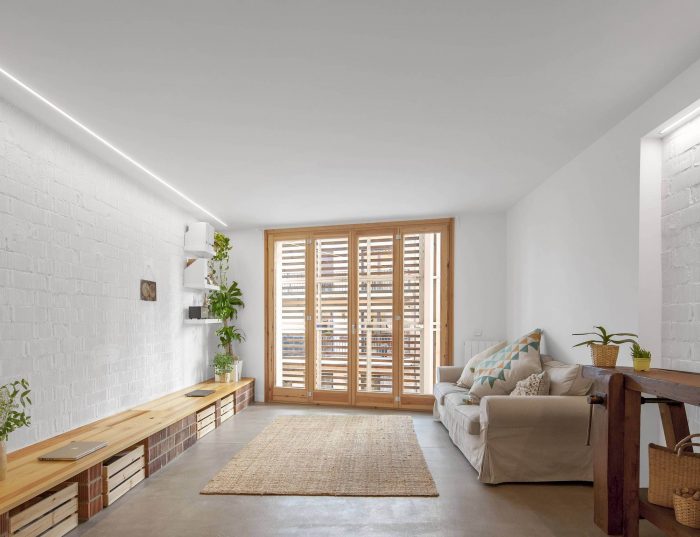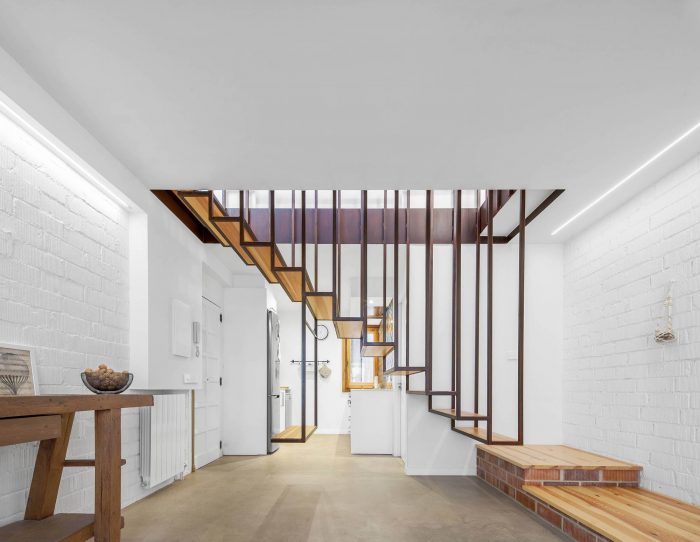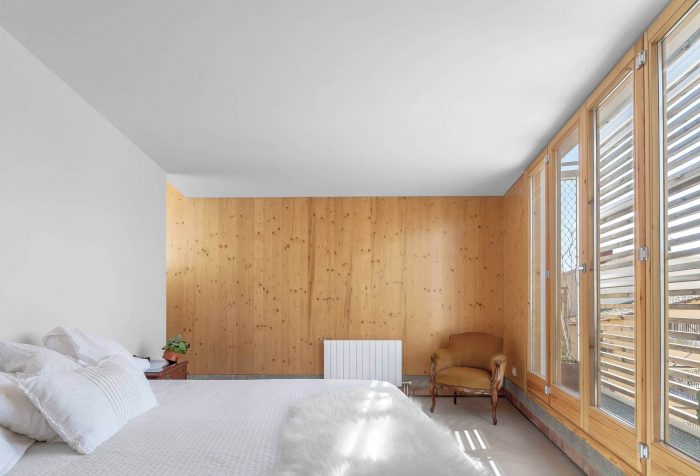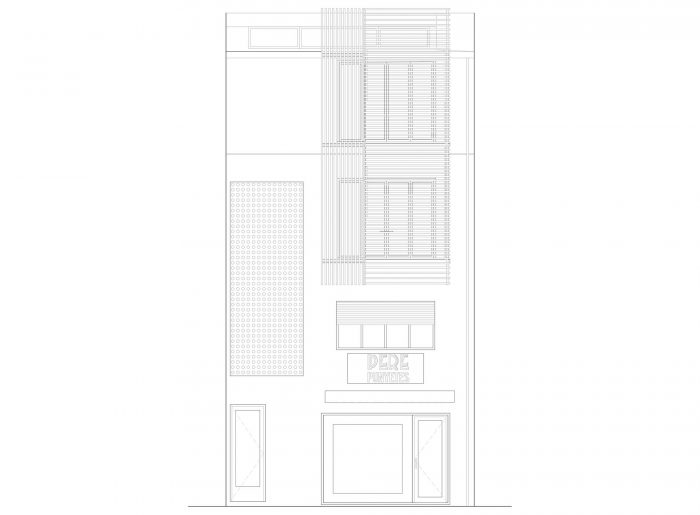该项目是基于对位于Sant Esteve de Palautordera中心的一栋70年代的三层多户住宅楼的升级改造,采用陶瓷结构墙体建造。一对没有孩子的年轻夫妇希望有一个适应他们当前和未来需求的家。在通道层(一个旧仓库)有一个厨房-餐厅和一个小浴室和洗衣房。在顶层和升级后的楼层,有三个房间(其中两个房间是相连的,有一个不太明确的程序)和一个浴室。走廊利用其在更高的屋顶下的情况来照明,并与生物气候行为合作。传统建筑屋顶的重量被一种新的轻型木质结构所取代,因为它对环境影响小,热性能好。新的结构体系依托于现有的陶瓷结构墙体,在不影响建筑地基的前提下实现快速施工,从而不影响底层餐厅的活动。
The project is based on the upgrade of a 70’s three-store multi-family residential building in the center of Sant Esteve de Palautordera, built with structural ceramic walls. A young couple without children wanted a home adapted to their current and future needs. On the access floor (an old warehouse) there is a Kitchen-Dining Room and a small bathroom and washing room. On the top and upgraded floor, there are three rooms (two of them connected and with a less defined program) and a bathroom. The hallway takes advantage of its situation under a higher roof to illuminate and collaborate with the bioclimatic behavior. The weight of the traditional construction roof is replaced with a new light wooden structure due to its low environmental impact and good thermal performance. The new structural system leans on the existing ceramic structural walls and allows a fast construction process without affecting the foundation of the building and, therefore, the activity of the ground floor restaurant.
材料性响应了尊重原有的意愿,同时也适应了经济预算。在现有的地面上,旧的结构砖墙被刷成白色,以提供一些舒适感。只有用于银行建设的新砖没有刷漆。在上层木质结构中,通过给结构墙面做杉木饰面来寻求温暖,而不属于结构墙面的则全部刷成白色。地下室的木质墙体保持可见,以说明房屋的构造现实。钢梯介于两种构造现实之间,完全悬挂在楼板上,追求轻盈,避免影响通道厂房的透明度。在通道门旁边,做了一个挂起大衣的手势,并表现为脱鞋的长椅。项目通过外立面寻求与环境的对话。围护结构保持了原有建筑的颜色和外观,但为了允许出口,控制阳光的入射,提高私密性,设置了一个外廊。轻质的钢结构、包层铺面和网状侧面,将整组折叠木板条从外立面中分离出来,重新诠释了传统的阳台和百叶窗。
The materiality responds to the will to respect the pre-existences, as well as adjust to the economic budget. On the existing floor, the old structural brick walls are white-painted to provide some comfort. Only the new bricks used for the construction of the bank were left unpainted. In the upper floor wooden structure, the warmth is sought by giving a fir finish to the structural walls while all those that are not part of it are painted white. The basement of wooden walls stays visible to illustrate the constructive reality of the home. The steel ladder, halfway between the two constructive realities and completely hanging from the slab, seeks lightness to avoid affecting the transparency of the access plant. Next to the access door, a gesture is done to hang up the coats and perform as a bench to remove the shoes. The project seeks dialogue with the environment through the façade. The envelope maintains the color and appearance of the pre-existing building, but an exterior gallery is being placed to permit an exit, control the sun’s incidence and improve privacy. A lightweight steel structure, with cladding pavements and mesh sides, separates from the façade the whole set of folding wood slats which reinterprets the traditional balcony and blinds.
该项目基于 “主动用户/被动式建筑 “策略,将空调能耗降低到8KWh/m2/年以下。在冬季,主立面的大窗户以及降低阳台板条的可能性,让您享受到巨大的太阳能捕获。这些能量被保存在混凝土板中,作为房屋的惯性储存。夏季有两种策略:防止太阳辐射和良好的自然通风系统。第一个是通过立面遮阳系统来保证,板条的放置可以保护它们免受阳光直射。另一方面,屋顶的形状被用作太阳能烟囱。由于文丘里效应,东、西两个方向会在上部产生过热,提供持续的气流,通过顶部的窗户排空。
The project is based on the “active user/passive building” strategies to decrease the air conditioning energy consumption under 8KWh/m2year. During winter, the large windows of the main façade as well as the possibility of lowering the slats on the balcony allow you to enjoy a great solar capture. This energy is being kept in the concrete slabs, acting as the inertia storage of the house. There are two summer strategies: protection from solar irradiation and a good natural ventilation system. The first one is guaranteed with the façade shading system, where the placement of the slats protects them from direct sunlight. On the other hand, the roof shape is used as a solar chimney. The East and West orientations generate an overheating on the upper part offering a constant airflow evacuating through the top windows thanks to the Venturi effect.
建筑师:OBO Estudi
面积:100 m²
年份:2018年
摄影:Andrés Flajszer
厂商:AutoDesk, Kerakoll, Simón, Pando, Roca
工程:Sergi Diaz Valdivia
合作者:Roger Vila i Pou
城市:San Esteban de Palautordera
国家:西班牙
Architects: OBO Estudi
Area: 100 m²
Year: 2018
Photographs: Andrés Flajszer
Manufacturers: AutoDesk, Kerakoll, Simón, Pando, Roca
Engineering:Sergi Diaz Valdivia
Collaborators:Roger Vila i Pou
City:San Esteban de Palautordera
Country:Spain



















